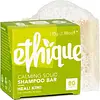What's inside
What's inside
 Key Ingredients
Key Ingredients

 Benefits
Benefits

 Concerns
Concerns

 Ingredients Side-by-side
Ingredients Side-by-side

Sodium Coco-Sulfate
CleansingKaolin
AbrasiveWater
Skin ConditioningPrunus Armeniaca Kernel Oil
MaskingSodium Cocoyl Isethionate
CleansingGlycerin
HumectantSimmondsia Chinensis Seed Oil
EmollientCocos Nucifera Oil
MaskingTheobroma Cacao Seed Butter
EmollientButyrospermum Parkii Butter
Skin ConditioningCitrus Grandis Seed Extract
AstringentTocopherol
AntioxidantCannabis Sativa Seed Oil
EmollientPanthenol
Skin ConditioningSodium Coco-Sulfate
CleansingSodium Cocoyl Isethionate
CleansingStearic Acid
CleansingTheobroma Cacao Seed Butter
EmollientDecyl Glucoside
CleansingWater
Skin ConditioningCocos Nucifera Oil
MaskingGlycerin
HumectantLactic Acid
BufferingCaprylic/Capric Triglyceride
MaskingAvena Sativa Kernel Meal
AbrasiveCitrus Aurantifolia Oil
CleansingBrassica Alcohol
EmollientSodium Isethionate
CleansingLimonene
PerfumingAzadirachta Indica Seed Oil
Skin ConditioningPongamia Glabra Seed Oil
Skin ConditioningBehentrimonium Methosulfate
Sodium Coco-Sulfate, Sodium Cocoyl Isethionate, Stearic Acid, Theobroma Cacao Seed Butter, Decyl Glucoside, Water, Cocos Nucifera Oil, Glycerin, Lactic Acid, Caprylic/Capric Triglyceride, Avena Sativa Kernel Meal, Citrus Aurantifolia Oil, Brassica Alcohol, Sodium Isethionate, Limonene, Azadirachta Indica Seed Oil, Pongamia Glabra Seed Oil, Behentrimonium Methosulfate
Ingredients Explained
These ingredients are found in both products.
Ingredients higher up in an ingredient list are typically present in a larger amount.
Cocos Nucifera Oil is obtained from the kernels of the coconut fruit. In other words, this is coconut oil.
Coconut Oil is rich in fatty acids with lauric acid making up the majority of these. It also contains linoleic acid. Due to this high fatty acid content, coconut oil helps trap moisture and soften skin.
Despite being antibacterial, coconut oil may not be great for acne-prone skin. It is comedogenic and may clog pores. This ingredient may not be safe for malassezia or fungal acne.
Note: Coconut Oil should not replace your sunscreen for UV protection. Studies show it only blocks about 20% of UV.
This oil is non-volatile and has a light scent.
The term 'fragrance' is not regulated in many countries. In many cases, it is up to the brand to define this term. For instance, many brands choose to label themselves as "fragrance-free" because they are not using synthetic fragrances. However, their products may still contain ingredients such as essential oils that are considered a fragrance.
Learn more about Cocos Nucifera OilGlycerin is already naturally found in your skin. It helps moisturize and protect your skin.
A study from 2016 found glycerin to be more effective as a humectant than AHAs and hyaluronic acid.
As a humectant, it helps the skin stay hydrated by pulling moisture to your skin. The low molecular weight of glycerin allows it to pull moisture into the deeper layers of your skin.
Hydrated skin improves your skin barrier; Your skin barrier helps protect against irritants and bacteria.
Glycerin has also been found to have antimicrobial and antiviral properties. Due to these properties, glycerin is often used in wound and burn treatments.
In cosmetics, glycerin is usually derived from plants such as soybean or palm. However, it can also be sourced from animals, such as tallow or animal fat.
This ingredient is organic, colorless, odorless, and non-toxic.
Glycerin is the name for this ingredient in American English. British English uses Glycerol/Glycerine.
Learn more about GlycerinSodium Coco-Sulfate is a type of sulfate.
Sodium cocoyl isethionate is a natural ingredient from coconut oil. It is an ultra gentle cleanser that gives a nice foam without drying the skin or impacting the skin barrier.
The amount of foam created depends on the amount of sodium cocoyl isethionate used in the product.
This ingredient also helps improve the spreadability of a product.
Learn more about Sodium Cocoyl IsethionateTheobroma Cacao Seed Butter comes from the Theobroma cacoa, or Cacao tree. Cacao trees are native to tropical landscapes.
Like other plant butters, Cacao seed butter is an emollient. Emollients help soothe and soften your skin. By creating a barrier to trap moisture in, emollients help keep your skin hydrated.
Cacao seed butter contains antioxidants known as polyphenols. Antioxidants help fight free-radical molecules by stabilizing them. Unstable free-radicals may cause damage to your skin cells. Antioxidants may help with anti-aging.
Theobroma Cacao Seed Butter can be bad for acne prone skin.
Learn more about Theobroma Cacao Seed ButterWater. It's the most common cosmetic ingredient of all. You'll usually see it at the top of ingredient lists, meaning that it makes up the largest part of the product.
So why is it so popular? Water most often acts as a solvent - this means that it helps dissolve other ingredients into the formulation.
You'll also recognize water as that liquid we all need to stay alive. If you see this, drink a glass of water. Stay hydrated!
Learn more about Water